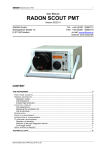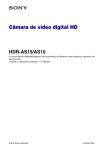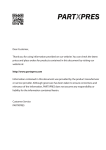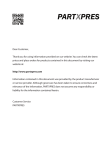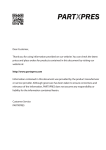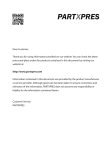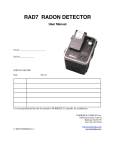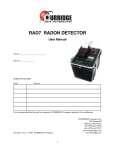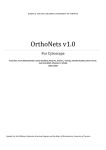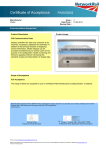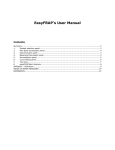Download Analogous Radon Sensor
Transcript
SARAD GmbH Analogous Radon Sensor -1- User Manual Analogous Radon Sensor (Indoor Air Sensor / Soil Gas Sensor) Version 12/2007 SARAD GmbH Wiesbadener Straße 10 D-01159 Dresden GERMANY Tel.: +49 (0)351 / 6580712 FAX: +49 (0)351 / 6580718 e-mail: [email protected] Internet: www.sarad.de Important hint The unit contains touchable parts which are biased with a high voltage even if the power supply has been interrupted. This can cause a dangerous electrical shock. Only skilled personnel trained in handling this type of equipment should open the enclosure. Content Common................................................................................................................................ 2 Theory of Operation .............................................................................................................. 2 Analogous Outputs................................................................................................................ 4 Defining the Measurement Range ..................................................................................... 4 Connecting the analogous outputs to a data acquisition system ........................................ 5 Voltage output configuration .......................................................................................... 5 Current output configuration .......................................................................................... 5 Test Function..................................................................................................................... 6 Digital Output ........................................................................................................................ 6 Alarm Output ..................................................................................................................... 6 Pulse Output...................................................................................................................... 7 Test Function..................................................................................................................... 8 Serial Interface (RS232) ........................................................................................................ 8 Internal Data Logger.............................................................................................................. 8 Starting and Stopping a Measurement .................................................................................. 9 Power Supply ........................................................................................................................ 9 Connectors...........................................................................................................................10 Indoor Air Sensor..............................................................................................................10 Electronic Box for Soil Gas Probe.....................................................................................11 Technical data......................................................................................................................12 Manual_AnalogousRadonSensor_EN_05-12-07.doc SARAD GmbH Analogous Radon Sensor -2- Common The Analogous Radon Sensor converts a measured Radon or Thoron concentration into an analogous signal with a span of either 0 to 1 V or 0 to 20 mA. The measurement range can be matched to the local requirements by software. A programmable digital switch output can be used as an alarm switch or a nuclide selective pulse (counting) output. If the pulse output is used to determine the concentration values, the analogous outputs can be programmed to provide the signals of the internal Temperature and Humidity sensor. The variable signal routing opens a wide range of possibilities for the interconnection of the Analogous Radon Sensor with external data acquisition and control systems. The unit can be operated as a “stand alone” Radon monitor due to its internal data logger and the serial interface. The unit is shipped with the latest release of the Radon Vision software. Please read the related chapters of software manual. Theory of Operation Radon and Thoron will enter the high voltage biased measurement chamber by diffusion and/or pumping. The daughter nuclides Po-218 and Po-216 generated by the Radon/Thoron decay inside the chamber are ionised for a short time. These ions are collected by the electrostatic field on the surface of a semiconductor detector. The decay events of Po218/Po-216 and also those of all following daughter products of the Radon/Thoron decay chain will be counted by the detector. The detector electronics provide voltage pulses; the pulse height is proportional to the different emission energy of the single nuclides. A subsequent multi-channel analyser (MCA) records the frequency distribution (alpha spectrum) of the detected decays respective their emission energy. Serial Interface (RS232) HV BIAS TX Radon Chamber MCA rH/T Gauge Data Memory (non volatile) Power Supply Microprocessor Diffusion Chamber RX PUMP Digital Output DAC 1 D A DAC 2 D Real Time Clock A Fig. 1 Block diagram Indoor Air Sensor (with internal pump option) Manual_AnalogousRadonSensor_EN_05-12-07.doc Analogous Output 1 Analogous Output 2 GmbH Analogous Radon Sensor SUB-D9 SARAD Cable Connection up to 10 m -3- Serial Interface (RS232) RX MCA Radon Chamber Power Supply Data Memory (non volatile) Microprocessor HV BIAS Soil Gas Probe 7-pin CA Electronic Box TX Digital Output DAC 1 D A DAC 2 D Real Time Clock Analogous Output 1 Analogous Output 2 A rH/T Sensor Fig. 1b Block diagram of the Soil Gas Sensor (soil probe and electronic unit separated) Five separate energy intervals (Region of Interest = ROI) are defined within the alpha spectrum to cover the single daughter products. The assignments are given in the table below: ROI1 Po-210 ROI2 Po-218 ROI3 Po-216 ROI4 Po-214 ROI5 Po-212 The limits of each ROI are defined by a lower and an upper channel within the alpha spectrum. The limits have been determined during the energy calibration by the manufacturer. The calculation of the concentration values of Radon and Thoron are based on the number of detected decay events within a pre-defined counting interval (also named sample or integration interval). For detailed information read the application notes AN-002 and AN-004. Manual_AnalogousRadonSensor_EN_05-12-07.doc SARAD GmbH Analogous Radon Sensor -4- Analogous Outputs The Analogous Radon Sensor offers two analogous signal outputs which can be factory configured either as voltage output (0 ... 1V) or current loop (0 ... 20 mA). The signals are generated by a digital to analogue converter (DAC) with subsequent buffer amplifier. The DAC resolution is 10 bit resulting in a minimum output step width of 1 mV or 0.02 mA. The voltage/current values are calculated at the end of each integration interval with respect to the measured Radon/Thoron concentration and the user defined measurement range. the output voltage will be changed after completing the current interval and remains at this level until the subsequent interval has been completed The instrument offers the possibility to output the Temperature and Humidity signal at the analogous outputs instead of the concentration values. The table below shows the assignment of the output channels. rH/T setting Analogous Output 1 Analogous Output 2 rH/T output disabled Radon Concentration Thoron Concentration rH/T output enabled Temperature relative Humidity Defining the Measurement Range To fit the measurement range to the analogous output range, an upper measurement range limit has to be defined. The lower range limit is always set to zero meaning that 0 Bq/m³ resulting in an output signal of 0 V or 0 mA. The upper limit defines the concentration value where an output signal of 1 V or 20 mA is generated. The expected signal voltage for a measured concentration value can be calculated by: VOUT = measured value * 1 V / upper range limit or IOUT = measured value * 20 mA / upper range limit Example: 5000 Bq/m³ has been defined as upper range limit, the actual reading is 2363 Bq/m³. The output voltage will be set to: VOUT = 2363 Bq/m³ * 1 V / 5000 Bq/m³ = 0,473 V A current output will be set to: IOUT = 2363 Bq/m³ * 20 mA / 5000 Bq/m³ = 9,45 mA. Readings above the upper limit generate output levels of 1 V or 20 mA. If the measured values appear frequently close to the upper limit, the range limit should be extended. From the start of a new sample until finishing the first integration interval 0 V or 0 mA are applied to the outputs. The output ranges for the Temperature and Humidity sensor are fixed: 0 ... 1 V / 0 … 20 mA = 0 ... 50 °C 0 ... 1 V / 0 … 20 mA = 0 ... 100 %rF Manual_AnalogousRadonSensor_EN_05-12-07.doc SARAD GmbH Analogous Radon Sensor -5- Connecting the analogous outputs to a data acquisition system Voltage output configuration The output impedance of the buffer amplifier is approximately 50 Ohm. Therefore, the input impedance of the connected signal input should not be lower than 10 kOhm. If longer signal wires are used, the power supply grounds of the Analogous Radon Sensor and the data acquisition system should be galvanically isolated by a transformer or by an isolated DC/DC converter. Radon Sensor Data Acquisition System VIN 0 ... 1V VOUT V DAC GND min. 10 kOhm GND Fig. 2 Connection to a 0 ... 1 V input Current output configuration The maximum driving voltage of the current loop is 4.5 V. To get the full signal range, the connected load resistance must not exceed the value of 225 Ohm. Case 1 Connection to a galvanic (e.g. optical) isolated current input: Radon Sensor Data Acquisition System IIN+ IOUT+ VDAC IINIOUT- isolated input GND 50 Ohm GND Fig. 3 Connection to an isolated 0 ... 20 mA input Case 2 Connection to a voltage input using a conversion resistor: Radon Sensor Data Acquisition System IOUT+ VIN RC max. 225 Ohm VDAC IOUT- GND GND GND VIN = R C* I 50 Ohm Fig. 4 Connecting the current loop to a voltage input Manual_AnalogousRadonSensor_EN_05-12-07.doc SARAD GmbH Analogous Radon Sensor -6- The galvanic isolation of the ground potential (GND) of the Analogous Radon Sensor and the data acquisition system is strictly required in case 2. The voltage span can be defined by the value of the conversion resistor RC (max. 225 Ohm) following Ohm’s law: RC = E / I. Example: The desired input voltage for a 20 mA full scale output signal shall be 4 V: R = 4 V / 20 mA = 200 Ohm Test Function This feature allows the operator to apply a user defined voltage (0 ... 1000 mV) to the analogous outputs by the PC-software. It may be very helpful to check the signal flow without Radon atmosphere if the sensor is used in complex data acquisition systems. If the outputs are configured as current loops, the desired current values have to be converted into their voltage equivalents first (the software will accept voltage values only, e.g. 10 mA 500mV). The test function is only available if a running measurement has been stopped before. Digital Output The driver stage of the digital output consists of an N-channel FET with an inserted pull-up resistor of 10 kOhm, this is tied to the internal supply voltage of 5 Volts (figure). This allows connection of the output directly to the TTL/CMOS inputs of a subsequent data acquisition system. The signal is active LOW. That means, if the output is active the terminal is tied to ground potential (GND). Radon Sensor Data Acquisition System +5V 10kOhm TTL IN min. 100kOhm DOUT GND GND Fig. 5 Connection to a TTL/CMOS input The digital output can be programmed by software either as an alarm switch or as a nuclide sensitive pulse output. Alarm Output The output becomes active if the measured concentration value exceeds a user defined alert level. The output remains active until the concentration drops below this level for at least one sample interval. If a relay is to be connected directly to the output, the applied coil voltage has to be less than or equal to 5 Volts. If higher coil voltages are required the internal pull-up resistor has to be removed by the manufacturer. A recovery diode has to be connected in parallel with the relay coil (figures below). Manual_AnalogousRadonSensor_EN_05-12-07.doc SARAD GmbH Analogous Radon Sensor -7- The maximum sink current is 50 mA, the maximum applied voltage to the output terminal is 15 Volts. +5V max. Radon Sensor +5V 10kOhm DOUT GND Fig. 6 Direct 5V relay connection +15V max. Radon Sensor +5V DOUT GND Fig. 7 Connecting a relay with higher coil voltage than 5V The alert output offers a simple way to detect a temporary range overflow. If the alert level is set to the same value ie the upper limit of the measurement range. The output then becomes active (LOW) as soon as the concentration exceeds the given limit. The output signal can then be connected to an additional input of the data acquisition system. Pulse Output The usage of the pulse output for the Radon/Thoron measurement is recommended if concentration changes over few magnitudes of order are expected. If the analogous signal is to be used, then the upper range limit has to be set to the maximum expected concentration value. Because of the limited output step width (1024 steps), small concentration changes would become invisible. Example: The maximum expected Radon concentration is around 900 kBq/m³. The upper range limit has to be set at least to 1000 kBq/m³. If now appear low concentrations, say below 1000 Bq/m³, a change from 600 Bq/m³ to 800 Bq/m³ can not be detected. Further advantages of the pulse output are the direct information about the counting statistics (related to the statistical error) and the possibility to use the analogous outputs to log the Temperature and Humidity simultaneously. The decay events of the single nuclides can be masked for the pulse output using the five assigned ROI. Each ROI can be enabled/disabled independently by software (see manual Radon Vision). All enabled ROI’s are logical “AND” gated. Then the decay of different nuclide results are in an output pulse. The TTL/CMOS output pulses (HIGH-LOW-HIGH) will be present for only a few Microseconds after the decay event. The pulse width is approximately Manual_AnalogousRadonSensor_EN_05-12-07.doc SARAD GmbH Analogous Radon Sensor -8- 16 microseconds. Take care with the input capacitance (including cable) of the data acquisition system. Values higher than 300 pF together with the internal 10 kOhm pull-up resistor result in flat signal slopes. The Radon concentration is linearly proportional to the number of detected decay events of the Po-218 (ROI2) and the Po-214 (ROI4). The Thoron concentration is linearly proportional to the number of detected Po-216 decays (ROI3). The calculation procedures are shown in the table below: ROI1 ROI2 ROI3 ROI4 ROI5 Value X Radon (fast) X X Radon (slow) X Radon (Po-214 only) X Thoron Calculation CRn (fast) = N / (T * Sfast) CRn (slow) = N / (T * Sslow) CRn(Po-214) = N / (T *(Sslow – Sfast)) CTn = N / (T * SThoron) X ROI disabled ROI enabled N T S Number of counts detected within all enabled ROI Time period used for counting Sensitivity (calibration constant stated within the calibration certificate) In mixed atmospheres (both, Radon and Thoron are present) an influence of each value to the other is given. In this case only the Po-214 (ROI4) should be used to calculate the Radon concentration (third line in the table). For additional information read the application note AN-004. Test Function For signal flow check, the digital output can be activated/deactivated by software. The test function is only available if a running measurement has been stopped before. Serial Interface (RS232) The serial interface allows operation parameters to be adjusted and to download the data stored by the internal data logger. This offers the possibility of getting the actual readings while the measurement is still running. All necessary functions for this are provided by the PC software. The simple binary transfer protocol will be forwarded on request. Internal Data Logger The time distributions of Radon and Thoron as well as Temperature and Humidity are recorded and stored by the internal data logger. In addition the alpha spectrum of the whole measurement period is available. The time distribution is stored in a non-volatile memory while the sum spectrum is lost in the event of a power interruption. The memory allows storage of up to 344 records. If this limit is reached, the data logging will be stopped automatically. The functions of the analogous and digital outputs are not affected. The data can be read from the logger after stopping the sample by software control. After starting a new measurement, the older data will be overwritten if the first integration interval has been Manual_AnalogousRadonSensor_EN_05-12-07.doc SARAD GmbH Analogous Radon Sensor -9- completed. Repeating a data download is possible by stopping the measurement again during this period. The alpha spectrum will still be lost because it contains counts already detected since restarting. Starting and Stopping a Measurement The measurement starts automatically once a supply voltage has been applied to the unit. The operation parameters will remain unchanged because they are stored in a non-volatile memory. This ensures the restart of the system in the event of an unintended power interruption without any external intervention. The measurement has to be stopped to use the test functions, download the data, or if operation parameters are to be changed. Following that, the measurement has to be started again by a short power interruption or by the software. The internal real time clock is not buffered and will loose its data after power interruptions. This is not a problem if only the analogous/digital outputs are used. In this case, the time synchronisation is provided by the subsequent data acquisition system. Be careful if the internal data logger is to be used. Set the time first and then start a measurement, both functions are altered via Radon-Vision software. Failure to set the time will result in the stored time distribution always starting at January 1st 2000. Power Supply The Analogous Radon Sensor accepts supply voltages between 11.2 and 15 Volts. This allows the usage of an AC/DC adapter as well as a 12 V lead acid battery. The total current consumption is less than 100 mA including 2 x 20 mA for the analogous signal currents. A galvanic isolation of the Analogous Radon Sensor from the power line and from the data acquisition system is always recommended. It is strictly required if the outputs are configured as current loop and connected to the ground potential of the data acquisition system (e.g. if a conversion resistor is used). This isolation avoids ground loops in the event of voltage outputs which can shift the analogous signal levels, especially if long signal cables are used. Mains Power P N AC GND 11.2 ... 15VDC DC IOUT+/VOUT Data Acquisition System IN IOUT-/GND Radon Sensor GND Fig. 8 Simple galvanic isolation of the Analogous Radon Sensor Manual_AnalogousRadonSensor_EN_05-12-07.doc SARAD GmbH Analogous Radon Sensor - 10 - Connectors The Analogous Radon Sensor provides four connectors. The figures show the front view of the connectors. The pin assignment is stamped into the plastic housing of the sockets. Two different types of connectors (Hirschmann or Binder) are used depending on the product version. Indoor Air Sensor Manufacturer: HIRSCHMANN series CA (IP67) Power supply (four pin wall mounted male connector) 1 GND 2 Supply voltage (11.2 to 15 Volts) 3 not connected 4 not connected 3 2 1 Serial interface (7-pin wall mounted male connector) 1 GND 2 RS232 TX (transmitter output of the Analogous Radon Sensor) 3 RS232 TX (receiver input of the Analogous Radon Sensor) 4 not connected 5 not connected 6 not connected 7 not connected 4 3 7 2 1 5 6 Digital output (four pin wall mounted female connector) 1 GND 2 DOUT 3 not connected 4 not connected 3 2 1 Analogous outputs (7-pin wall mounted female connector) 1 Analogous output 1; V_OUT / I_OUT+ 2 Analogous output 1; GND / I_OUT – 3 Analogous output 2; V_OUT / I_OUT+ 4 Analogous output 2; GND / I_OUT5 not connected 6 not connected 7 not connected Manual_AnalogousRadonSensor_EN_05-12-07.doc 4 5 6 3 7 2 1 SARAD GmbH Analogous Radon Sensor - 11 - Electronic Box for Soil Gas Probe Manufacturer: BINDER series 710 Power supply (two pin female socket) 1 GND 2 Supply voltage (11.2 to 15 Volts) 1 2 Serial interface (four pin female socket) 1 GND 2 RS232 TX (transmitter output of the Analogous Radon Sensor) 3 RS232 RX (receiver input of the Analogous Radon Sensor) 4 not connected 2 3 1 4 Digital output (three pin female socket) 1 GND 2 DOUT 3 not connected 2 1 3 Analogous outputs (five pin female socket) 1 Analogous output 1; V_OUT / I_OUT+ 2 Analogous output 1; GND / I_OUT – 3 Analogous output 2; V_OUT / I_OUT+ 4 Analogous output 2; GND / I_OUT5 not connected Manual_AnalogousRadonSensor_EN_05-12-07.doc 3 2 4 1 5 SARAD GmbH Analogous Radon Sensor - 12 - Technical data Theory of operation High voltage biased chamber with semiconductor detector Sampling Diffusion through a large area 125µm silicon rubber membrane internal sealed air loop, optionally driven by a pump Sensitivity Indoor Air Sensor Soil Gas Probe typical 3.1/6.5 counts/min @ 1000 Bq/m³ (fast/slow) typical 0.8/1.8 counts/min @ 1000 Bq/m³ (fast/slow) Response time (125µm silicon membrane) Indoor Air Sensor 30/150 Minutes (fast/slow) with pump option Soil Gas Probe 60/180 Minutes (fast/slow) Range Radon Temperature Humidity Enclosure Indoor Air Sensor Material Dimensions Weight Soil Gas Sensor Material Dimensions Weight 0 ... 10 MBq/m³ 0 ... 50 °C 0 ... 100% Aluminium (powder coated), wall mounting possible 280 mm x 230 mm x 111 mm (W x H x D) approx. 4000 g Electronic box Aluminium (powder coated) Soil Gas Probe stainless steel and Acetal Electronic box 175 mm x 57 mm x 32 mm (W x H x D) Probe 76.1 mm dia. x 125 mm Electronic box approx. 250 g Probe approx. 650 g Integration interval 1 ... 255 Minutes adjustable in 1 Minute steps Radon calculation Alpha spectroscopy Memory 344 data records and sum spectrum, non-volatile Interface Analogue either 2 x 0 ... 1 V or 0 ... 20 mA (1024 steps) either Radon/Thoron OR Temperature/Humidity upper range value programmable for detailed electrical specifications see manual Digital Open drain with internal pull-up resistor (TTL/CMOS) Alert switch OR direct output of decay pulses for detailed electrical specifications see manual Serial 115200 baud, 8N1, only RXD, TXD and GND are used Power supply 11.2 ... 15 VDC, < 100 mA Software Radon Vision Manual_AnalogousRadonSensor_EN_05-12-07.doc












